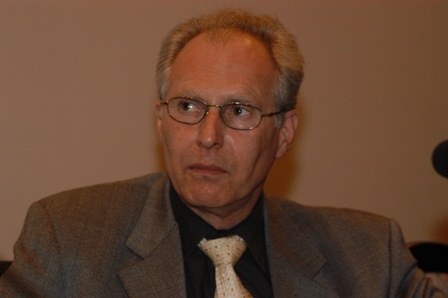«Humanae Vitae»
A Scientific Prophecy
4th January 2009
By José María Simón Castellví
President of the World Federation of Catholic Medical Associations (FIAMC)
The Federation over which I have the honour of presiding has recently published an official document to mark the fortieth anniversary of the publication of the encyclical letter Humanae Vitae, by Pope Paul VI, of venerable memory. This hundred-page document is a highly technical work containing three hundred citations, mostly taken from specialised medical journals.
The document has come into being after many months of intense research and data collection. It is fitting to recall the person responsible for its publication, the Swiss doctor, Rudolf Ehmann, who spent the same number of months drafting the document as there are in the gestation period of any human pregnancy. Never before has similar work been produced, from the medical point of view, given the way in which we, as doctors, are accustomed to working and writing. In addition to being well written, the original German text is also extremely interesting. However, what are the keys to its reading? Does it contribute anything new to the Church or to society? Its author should be considered an expert, and one who is suitably qualified to assess important aspects of contraception. Written in accordance with scientific requirements, and well grounded regarding obstetrics and gynaecological aspects, it reached two conclusions that should not go unnoticed, neither within the Church nor beyond.
First, it irrefutably demonstrates that the most widely used anovulatory contraceptive in the industrialised world, containing a low dose of oestrogen and progestin hormones, works in many cases as an anti-implantation agent as it expels the forming human embryo. The embryo, in early stages of development, is something more than just an egg cell. The embryo grows in such a continuous, coordinated and gradual manner that, should nothing prevent it from doing so, it will emerge from the maternal womb in just nine months, ready to devour litres of milk. This anti-implantation effect is accepted in the scientific literature, which even shamelessly uses the term ‘embryonic loss rate’. Curiously, however, this information is seldom disclosed: It is recognised by researchers and is included in the prospectuses of pharmaceutical contraceptive products.
Another interesting aspect concerns the devastating ecological effects of the tons of hormones that have been released into the environment over the last few decades. We have enough data to affirm that one reason for the considerably high levels of male infertility in the West (increasingly lower sperm counts) is the environmental pollution caused by products such as the ‘pill’. We are dealing here with a situation that is clearly detrimental to the ecosystem, and one which should exact further explanations from pharmaceutical companies. The other side effects of oestrogen and progestin combinations are widely recognised. The World Health Organisation’s International Agency for Research on Cancer, based in Lyons, in its press release on 29th July 2005, noted the carcinogenic nature of combined oestrogen-progestin oral contraceptives and classified them as Group One carcinogens.
The saddest part of all this is that, in terms of regulating fertility, these products are unnecessary. Natural family planning (NFP) methods are equally effective and, in addition, respect the ‘nature of the person’.
On the sixtieth anniversary of the Universal Declaration of Human Rights, it can be said that artificial contraception violates at least five important human rights: the right to life; the right to health; the right to education; the right to information (its diffusion is carried out to the detriment of information on natural methods); and the right to equality between the sexes (women almost always bear the responsibility for contraception issues).
FIAMC has been committed to science and truth since its very founding. Therefore, we study and raise discussion on both the main effect as well as the side effects of these drugs. Our activities, however, extend beyond examining contraceptive products which have consistent side effects or even those which are of little or no effect. Our work goes much further than that.
Sexuality is a wonderful God-given gift within the Sacrament of Matrimony. It unites husband and wife so much that any external element that comes between them is an illegitimate third party. Spouses give of themselves wholeheartedly, and do so also in terms of their own reproductive capacity. If a new life is not possible, for serious reasons, conducting sexual relations during non-fertile periods should form part of conjugal intimacy, which must always be both satisfying and serve as a bond between husband and wife. To those who see some of the documents of the Church as a compendium of prohibitions, I strongly recommend that they read the civil, criminal or commercial codes of some Western countries, which are full of prohibitions. I do not dispute their appropriateness, but I do believe that those same codes are based on the fundamental premises of personal and commercial freedom, geared towards people’s happiness and to the efficiency of companies and which, ultimately, justify certain prohibitions. The Church holds sexuality in great esteem and I believe, through acquiring correct habits and education, that life may become easier and that certain limits, which do indeed exist, may be viewed positively.
We, as Catholic doctors, are fully aware that much more should be invested in maternity; and more, also, invested in human resources, education and financial resources. The Humanae Vitae doctrine has not been followed because, among other reasons, it has been rejected by too many doctors.
Turning the question around may help us to see the extent to which Pope Paul VI was in actual fact prophetic. Had he accepted the ‘pill’, would we, today, be able to prescribe with a clear conscience some of the products that we now know to have an anti-implantation effect? The prestige of doctors enables them to offer couples alternatives to artificial contraception. The relationship between doctor and patient is strong enough that it is unlikely to be broken easily; not even by a dissident theologian. However, to avoid this from happening, we should provide doctors with more and better training and information on issues of fertility.
I believe that, as Catholic doctors, we will continue to develop our profession. Nevertheless, given the current situation – with slow progress, numerous reservations and the millions of people who are involved – I would respectfully ask the Church to create a special commission on Humanae vitae.
4th January 2009 · Osservatore Romano
………………………………………………………………








